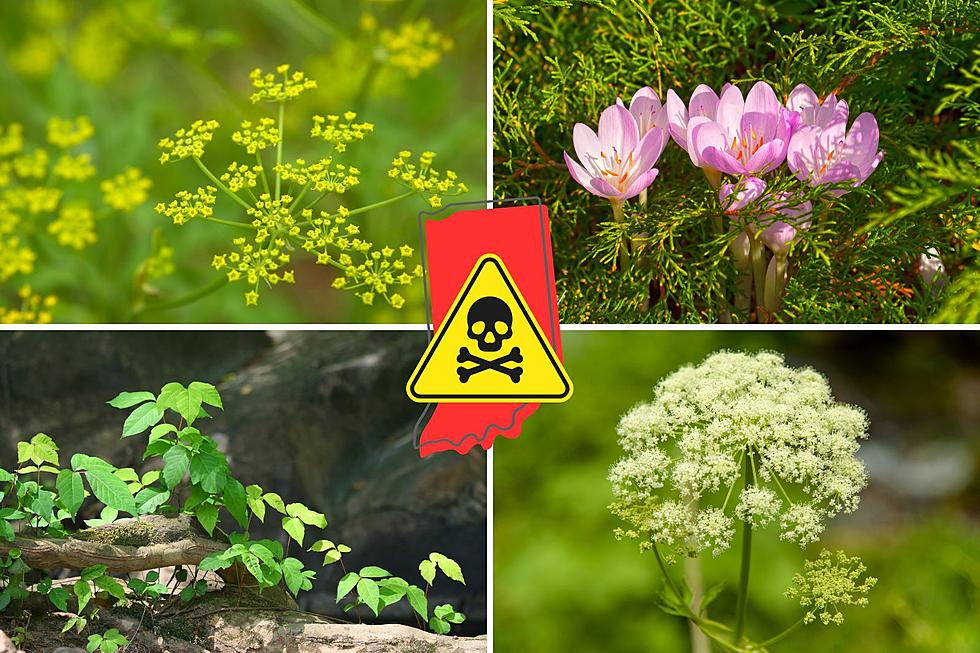
These 11 Poisonous Plants Found in Indiana Are Very Dangerous
There are eleven poisonous plants found in Indiana that could cause some serious issues and some could potentially be deadly!
As the weather is beginning to warm up here in Indiana, many Hoosiers will be outside a lot more. Whether you are outside fishing, hiking, camping, or even just walking around in your yard, you will notice a lot of different plants. While some of them might be pretty and you will be tempted to pick them or smell them, there are a few plants out there that are very dangerous to humans and animals that you need to be aware of.

Poisonous Plants Found in Indiana
When it comes to poisonous plants found here in Indiana, you may recognize the name of some of them, but can you identify them all? Now, this list from A-Z Animals doesn't include every single poisonous plant found in Indiana such as poison oak. However, it does feature the most dangerous plants found in the Hoosier State. Discover where these plants thrive and why they are so toxic if touched or ingested.
1. Autumn Crocus (Colchicum autumnale)
The poisonous autumn crocus is a popular garden plant and grows wild in wooded areas with moist soil. The autumn crocus looks very similar to wild garlic. So accidental poisoning can happen when people go searching for wild garlic but pick young and poisonous autumn crocus plants instead. According to A-Z Animals:
The autumn crocus contains a toxic alkaloid called colchicine, which blocks normal DNA synthesis and other body functions. Ingesting any part of the autumn crocus plant could lead to nausea, diarrhea, vomiting, and stomach pain. Additional and life-threatening symptoms that may take days to develop include organ failure and cardiac collapse, leading to death.
2. Belladonna (Atropa belladonna)
Belladonna tends to grow in woodlands, along fences and walls, and in other partly shady marginal areas. It is also often confused with blackberries. Here's what A-Z Animals says about the dangers of belladonna:
The toxic tropane alkaloids in belladonna plants include atropine, hyoscyamine, and scopolamine. Because of these dangerous alkaloids, ingesting any part of the belladonna plant could result in dry mouth, vomiting, rapid heartbeat, dilated pupils, blurred vision, difficulty swallowing, delirium, hallucinations, respiratory failure, and death.
3. Cow Parsnip (Heracleum maximum)
You can find this poisonous Indiana plant in woodlands, meadows, and near stream banks. While they might look nice, the last thing you want to do is touch them. You won't like what happens.
Cow parsnip produces toxic chemicals called furanocoumarins that cause strong allergic reactions on the skin. The resulting symptoms of phytophotodermatitis caused by these toxins are especially severe when the skin is in direct sunlight. Symptoms of cow parsnip poisoning can include an itchy and burning rash, painful blisters, and possibly permanent scarring.
4. Poison Ivy (Toxicodendron radicans)
This is one we are all familiar with, however, many people have trouble identifying the plant because it's often confused with poison oak. Neither of which you want to touch, obviously. Poison Ivy is found in shady wooded areas, fields, and along fences. According to A-Z Animals:
<p>Poison ivy plants are dangerous because they contain a toxin called urushiol that releases when the plants are disturbed. So touching or brushing your bare legs against this plant can cause an itchy skin rash, swelling, and blistering. Symptoms of poison ivy poisoning can last a few days or a couple of weeks in severe cases.</p><p>Urushiol is also the toxin in poison oak and poison sumac plants.</p>
5. Poison Hemlock (Conium maculatum)
Poison Hemlock is spreading fast throughout Indiana, and can be found along highways, edges of fields, fences, near streams, and in ditches. More recently, they have made their way to public parks, flower beds, and backyard gardens.
Poison Hemlock can harm pets and humans in a few ways. For example, if the sap from the plant gets on your skin, once it is exposed to sunlight it can cause blisters and welts. I don't know about you, but that's not something that I want to deal with this summer. However, that isn't even the worst way Poison Hemlock could hurt you or your pets. If any part of the plant were to be ingested somehow, it could be fatal...as in death! The Indy Star reports that Poison Hemlock contains "toxic alkaloids that can interfere with nerve transmissions to your muscles, ultimately causing respiratory failure."
6. Jimsonweed (Datura stramonium)
Jimsonweed thrives in the garden, as well as in disturbed and marginal areas like roadsides. This plant has been given the nickname stinkweed because of its unpleasant smell.
Avoid ingesting any part of the jimsonweed plant because of its toxic alkaloids. Two of this plant’s main toxins are scopolamine and atropine. The symptoms of jimsonweed poisoning include dry mouth, rapid heartbeat, confusion, dilated pupils, blurred vision, hallucinations, coma, and possibly death.
7. White Baneberry (Actaea pachypoda)
White baneberry habitats include forests, woodlands, thickets, and other shade-filled environments. This plant is extremely poisonous if you touch it or ingest it. According to A-Z Animals:
The white baneberry is one of the most poisonous plants found in Indiana because it has cardiogenic toxins that can harm the heart. This plant also contains ranunculin, which is an unstable glucoside that breaks down into glucose, and a toxin called protoanemonin. Baneberry’s toxins lead to skin rash and blistering if the plant is touched, plus worse symptoms if ingested. Eating its <a href="https://a-z-animals.com/blog/different-types-of-poisonous-berries-to-avoid-at-all-costs/" data-lasso-id="2113147">poisonous berries</a> or other parts of white baneberry plants can result in nausea, vomiting, stomach cramps, dizziness, rapid pulse, delirium, and circulatory failure that could be fatal.
8. Stinging Nettle (Urtica dioica)
The stinging nettle grows in areas with wet soil, like banks of rivers and streams, woodlands, meadows, and Indiana forest edges. You definatley don't want to touch these with your bare hands!
In addition to the sharp hairs on its foliage, stinging nettle contains neurotoxins like the neurotransmitters histamine, formic acid, and acetylcholine. So when you touch stinging nettle plants, the sting is partly due to these chemicals. Symptoms of stinging nettle poisoning include burning sensations on the skin that last up to 24 hours. However, some allergic reactions to the neurotransmitters could be more severe.
9. Water Hemlock (Cicuta maculata)
Much like poison hemlock, water hemlock resembles wild carrot plants and Queen Anne’s lace and can grow very tall. Water hemlock habitats include areas in and near water, like swamps, streams, and marshes.
The unsaturated alcohol called cirutoxin is the primary poison in water hemlock, and it’s a potent one. Ingesting any part of this plant is extremely dangerous, causing tremors, seizures, respiratory failure, nervous system failure, and death.
10. Wild Parsnip (Pastinaca sativa)
Wild Parsnip is a common wildflower in Indiana fields and disturbed areas. It's another plant that you don't want to touch at all. Here's what A-Z Animals says:
Wild parsnip is a dangerous Indiana plant because touching it can cause phytophotodermatitis caused by chemicals called furanocoumarins. The symptoms of phytophotodermatitis include an itchy and burning rash, blisters, and possibly scarring. These symptoms are even more severe when the affected skin is exposed to direct sunlight.
11. Pokeweed (Phytolacca americana)
You'll likely find pokeweed in disturbed areas, fields, and edge habitats like fence rows and roadsides here in Indiana. It's highly toxic to humans and animals if ingested.
Pokeweed toxins like phytolacca and saponins make all parts of this plant poisonous if ingested. The symptoms you could suffer from pokeweed poisoning include nausea, vomiting, diarrhea, convulsions, stomach cramps, and respiratory failure, which could be fatal.
(H/T- A-Z Animals)
7 Invasive Insects in Indiana You Should Kill Immediately If You See Them
Gallery Credit: Ryan O'Bryan
See 11 Unique Attractions You'll Only Find in Indiana
Gallery Credit: Ryan O'Bryan
10 Indiana Laws You Don't Know You're Breaking
More From WKDQ-FM









